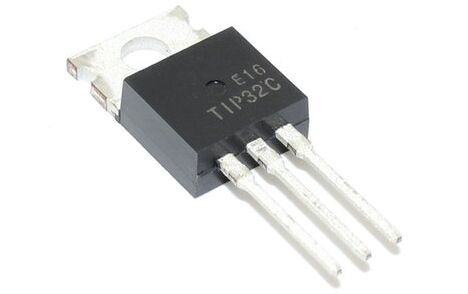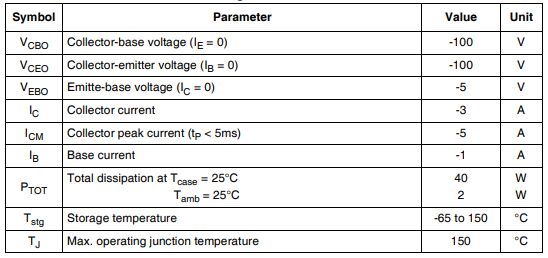By STMicroelectronics 202
TIP32C is a PNP transistor, which is a type of power transistor (Power Transistor). This type of transistor is commonly used in amplification and switching circuits, especially in applications requiring larger currents and powers.
TIP32C is a silicon epitaxial-based PNP power transistor packaged in JedecTO-220 plastic package. It is suitable for medium power linear and switching applications. The complementary NPN type is TIP31C.

Ⅰ.Main parameters of TIP32C
•Installation style:Through Hole
•Package/Box:TO-220-3
•Transistor polarity:PNP
•Configuration:Single
•Collector-emitter maximum voltage VCEO:100V
•Collector-base voltage VCBO:100V
•Emitter-base voltage VEBO:5V
•Collector-emitter saturation voltage:1.2V
•Maximum DC collector current:3A
•Pd-Power dissipation:40W
•Minimum operating temperature:-65℃
•Maximum operating temperature:+150℃
•Collector continuous current:3A
•Height:9.15 mm
•Length:10.4 mm
•DC current gain (hFE):50
•Rated power (Max):2W
•Minimum current amplification (hFE):10 @3A, 4V
•Breakdown voltage (collector-emitter):100 V
•Number of pins:3
•Dissipated power (Max):2000mW
Ⅱ.Pin functions of TIP32C
1.Collector,C: This is the main power output pin of TIP32C. It is connected to the load in the circuit and is responsible for collecting current and delivering it to the power source. In NPN transistor, the collector is the output terminal of the current, but in PNP transistor, it is the input terminal of the current.
2.Base,B: The base is the control pin of TIP32C. By controlling the base current (Ib) by applying a forward voltage between the base and emitter, the collector current (Ic) can be controlled. The base is responsible for regulating the working state of the transistor and controlling whether it is cut off or saturated.
3.Emitter,E: The emitter is the output terminal of the current. It is the N-type semiconductor region in the TIP32C through which current flows. The emitter is connected to ground (or the negative supply) in the circuit.
Ⅲ.Working principle of TIP32C
1.Three-layer structure: TIP32C has three main areas, namely Collector, Base and Emitter. These three regions correspond to P-type, N-type and P-type semiconductor materials respectively.
2.Amplification: When a forward voltage is applied between the base-emitter, this causes the injection of electrons and holes in the base region. These carriers will move towards the emitter region through the base-emitter junction. Since the emitter is a P-type semiconductor, these carriers will be absorbed, forming a collector current. Therefore, a small base current can control a larger collector current to achieve signal amplification.
3.Current flow: Under normal operating conditions, the current between the collector and emitter (called collector current Ic) is controlled by the current between the base and emitter (called base current Ib). When a forward voltage is applied between the base and the emitter, the PNP transistor is brought into a conductive state.
4.Cutoff and saturation: Controlling the size of the base current can adjust the working state of the transistor. When the base current is small, the transistor may be in an off state, with little collector current flowing. When the base current increases appropriately, the transistor will enter a saturation state, allowing greater collector current to pass.
Ⅳ.Absolute maximum ratings of TIP32C

Ⅴ.Electrical characteristics of TIP32C(Tcase = 25°C; unless otherwise specified)

Ⅵ.Application of TIP32C
1.Amplifier application: TIP32C is a common power amplifier transistor and is often used as the output stage of audio amplifiers and other medium power amplifiers. It is a PNP type transistor with high current capability and low voltage capability, making it suitable for many audio amplification applications. In audio amplifiers, the TIP32C can be used to amplify the signal from a preamplifier in order to drive speakers or other audio output devices. It is capable of handling high currents, providing enough power to drive low impedance loads such as speakers. TIP32C is also commonly used in other medium power amplifier applications, such as audio control, electroacoustic conversion, and instrument amplification. Its performance characteristics make it an ideal choice in many electronic devices, especially where high current drive capabilities are required.
2.Power supply regulator: TIP32C can be used in power supply regulator design as a regulating component to help stabilize the power output. In power regulators, TIP32C can work with other electronic components, such as resistors, capacitors, and inductors, to achieve stable output of the power supply voltage. By using TIP32C as the regulating component, the voltage regulator can dynamically adjust the output voltage according to changes in load demand and input voltage, thereby ensuring the stability and reliability of the power output. This stability is very important for many electronic devices, especially those that require precise control of voltage. It should be noted that the specific component selection and circuit design in the voltage regulator design depends on the system requirements and application scenarios. Therefore, when designing a voltage regulator using TIP32C as a regulating component, detailed system analysis and design are required to ensure the best performance and effect.
3.Switching mode power supply: TIP32C can be used as a switching element in a switching power supply circuit. In switch-mode power supplies, it helps achieve efficient energy conversion. Switch mode power supply (SMPS) is an efficient and reliable power conversion solution widely used in various electronic equipment. In this power supply design, the function of the switching element (such as TIP32C) is to control the on and off of energy, thereby achieving efficient energy conversion. TIP32C is a PNP transistor with high withstand voltage and high current characteristics, and is very suitable for use in switching power supplies. In the switching power supply circuit, TIP32C can be used as a switching element to chop the input electric music by controlling its on and off states, and then convert it into the required output voltage by changing components such as musical instruments.
4.Linear power regulator: A linear power regulator is a power circuit that stabilizes the power output by using linear components (such as TIP32C). In this circuit, TIP32C serves as an adjustment component and is adjusted by controlling its conduction degree. The output voltage. Linear power regulators have lower noise and better linearity, so in some applications that require higher power supply performance, such as audio or video equipment, linear power regulators may be used to stabilize the power output. In linear power regulators, the PNP transistor characteristics of TIP32C enable it to effectively control the current to stabilize the output voltage. By adjusting the base voltage of TIP32C, its conduction degree can be changed, thereby changing the output current and voltage of the power supply.
5.LED driver: TIP32C is a common LED driver that is often used in LED lighting applications. It is a PNP transistor with high withstand voltage and high current characteristics and can drive high-power LEDs. By controlling the current of TIP32C, the brightness of the LED can be adjusted to achieve precise control of the brightness and color of LED lighting. When using TIP32C to drive an LED, you need to connect the base of the TIP32C to the control signal of the LED, connect the emitter to ground, and connect the collector to the positive electrode of the LED. By adjusting the amplitude and frequency of the control signal, the on and off time of TIP32C can be controlled, thereby controlling the current and brightness of the LED.
6.Motor drive: TIP32C may also be used in the drive circuit of a DC motor to control the movement of the motor by controlling the current.
Frequently Asked Questions
1.What type of transistor is TIP32C?
TIP32C is a PNP (Positive-Negative-Positive) bipolar junction transistor (BJT).
2.Can TIP32C be used in motor driver circuits?
Yes, TIP32C can be used in motor driver circuits to control the movement of DC motors by regulating the current flow.
3.How does TIP32C function in amplifier circuits?
In amplifier circuits, TIP32C can amplify signals by controlling the current flow between the collector and emitter terminals.
4.Are there common alternatives to TIP32C?
Depending on the application, alternative PNP transistors with similar characteristics may be considered, but the specific choice depends on the circuit requirements.